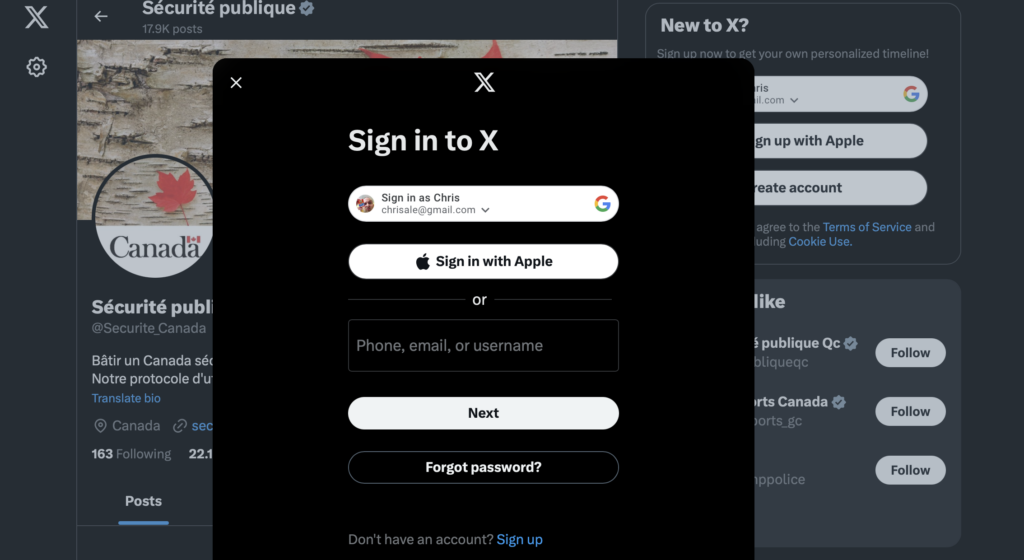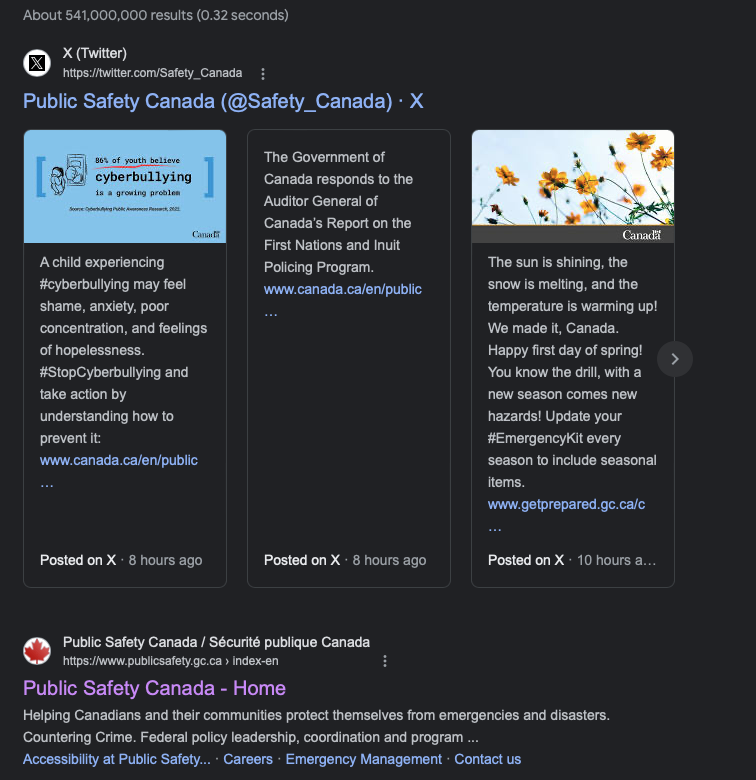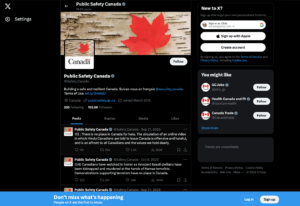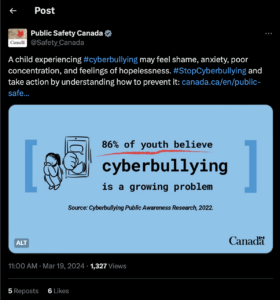I did a thing
As sometimes happens, I submitted a letter to a government official/agency today. What now you ask? Well, it has to do with something that has long interested me. Access to Information. Particularly when it comes to government institutions and their reluctance to access to the reams of information they generate out of sight of the public.
This time is a little different though. This time I have submitted a complaint to the Information Commissioner of Canada on a proactive basis. The question is this:
Is the use of corporate social media by government entities like, say Public Safety Canada, consistent with the spirit if not the word of the Access to Information Act if there are alternatives they could be using that would allow them to comply fully?
I asked this question on Mastodon last night.
It generated some interesting replies and considerations. So I went ahead and submitted a complaint. I decided to submit it to the Information Commissioner of Canada and direct the complaint toward Public Safety Canada as an example. This is all fairly top of mind as e-petition 4769 nears completion calling on Government to use the open social web for communications. (Please sign!)
I’ll recreate the complaint in full below but you can also download it in the original PDF format I sent to the Commissioner.
The Letter
March 20, 2024
Dear Mrs. Maynard – Information Commissioner of Canada,
I submit this complaint in relation to Public Safety Canada’s use of third party social media providers to disseminate critical information in times of emergency and crisis as well as for regular communication when options exist that would fully comply with the Access to Information Act.
I would encourage you to investigate this issue as broadly as you are able. Below are two general concerns:
- Whether Public Safety Canada (and possibly other government entities including yours) are living up to the spirit of the Access to Information Act when they use communication platforms that present automatic barriers to entry in the form of a login and password registration, including all of the privacy concerns that registration process may entail.
- Whether that intent and spirit of the Act is again violated when the public is prevented from accessing historical information and communication on third party social media platforms because Public Safety Canada does not have access to the third party’s infrastructure and information archive.
There are social media alternatives (known variously as “Fediverse”, “Mastodon” and “ActivityPub” among others) that could be controlled and used by Public Safety Canada and would fully comply with the Access to Information Act while providing the “reach” to all Canadians regardless of their membership on any particular third party social media platform.
Many problems have emerged with third party social media platforms including their sometimes arbitrary limits on who can view and interact with accounts in the moment plus access to historical records. There are also risks to Canadians submitting personal information to these platforms and questions of national security, criminal activity, and societal manipulation.
Canadians look to Public Safety Canada to obtain critical, potentially life altering, information. This makes its communications not only an essential service in the moment, but also a source of considerable debate and public scrutiny after the fact. It should be held to an exceptionally high standard when it comes to Access to Information. I hope you find the attached document further illuminates the questions on this issue.
Sincerely,
Chris Alemany
Supporting Justifications
Access to Information Act – DOES Government use of Social Media SATISFY its Responsibility?
To quote the Act, it’s purpose is: “to enhance the accountability and transparency of federal institutions in order to promote an open and democratic society and to enable public debate on the conduct of those institutions.”
In furtherance of that it provides “a right of access to information in records under the control of a government institution in accordance with the principles that government information should be available to the public”.
These purposes raise a number of questions as it relates to public institutions like Public Safety Canada using corporate, third party social media platforms as a means of communicating with the public.
Question 1: Is Public Service Canada “available to the public” if third party social media require Canadians to register and/or subscribe for that service?
Unlike a government website, social media accounts created within third party platforms are only available, in full, to Canadians who also participate on those platforms. See Appendix A for a demonstration and more information.
Question 2: Is Public Service Canada enhancing its “accountability and transparency” by relying on third party social media platforms?
The Facebook penetration rate is about 77% of the Canadian population1 . Twitter usage is at 8 million users in Canada2 3. Despite this large uptake, Public Service Canada acknowledges in its Social Media policy4 that its social media accounts are “an alternative method of sharing the content posted on our website” and they “accept no responsibility for platforms becoming unresponsive or unavailable”.
This reveals a confusing and contradictory reality that flies in the face of the spirit of enhancing “accountability and transparency of federal institutions”. Because of the use of third party social media platforms, Public Service Canada cannot, by its own admission, reach every Canadian on the Internet like it can the website and is at the mercy of those sites when it comes to reliability and accessibility.
While Public Safety Canada says social media is an “alternative”, it continues to use those third party platforms in times of “crisis, emergency, or significant event of national interest”.
The public has limited or no ability to request records of Public Safety Canada’s social media interactions if those records are not willingly provided by the third party. While this is provided for in the Act, it is not in its spirit, especially when open alternatives exist that would allow Public Service Canada to provide those same timely updates and also fulfill its requirements under the Access to Information Act?
Question 3: Is Public Service Canada promoting “an open and democratic society… to enable public debate” by using closed third party social media?
Every statement by a public body should be seen as an opportunity for debate and information sharing. By limiting its social media presence to those platforms controlled by closed third party systems and not — as demonstrated in Appendix A — reasonably accessible, searchable, viewable, and shareable to all Canadians I believe Public Service Canada is unable to complete its requirements in enabling that public debate.
By participating only in these ‘walled gardens’, Public Service Canada limits the scrutiny it may face, both in the immediate term, and later on from requests for access to information, from any interaction on those platforms.
Question 4: Does Public Service Canada have an obligation to control its own information and communication whenever it has the ability to?
Despite there being third party service providers for web services, email, and office administration, Public Safety Canada controls and operates, with the support of other organs of the Government of Canada, various services including:
- A public website at https://www.publicsafety.gc.ca
- Publicly accessible email addresses.
- Other electronic and written forms of communication.
By relying on third parties to provide the infrastructure for its social media communications, Public Safety Canada is abdicating its responsibility to take every reasonable measure to maintain control of its own critical records and information and by extension make that information available to the Canadian public.
Question 5: Do Government Officials and Officers of the Parliament of Canada – such as the Minister of Public Safety or Information Commissioner – have an obligation to use Open Social Media platforms?
As a companion to this complaint, I would like to draw your attention to a Petition to the Government of Canada e-4769 (Media and telecommunications) which states:
“We, the undersigned, residents of Canada, call upon the Government of Canada to enact policy and dedicate budgetary resources to enable the Parliament of Canada to provide an open, trusted, federated, social media presence for use by all members, senators, officers and other employees of Parliament as appropriate for communication to all Canadians.”
If you consult that petition and its justifications, I trust you will understand how these arguments further extend to this complaint.
Thank you very much for your time and consideration,
Chris Alemany
Appendix A – Banging on the Wall
1) Facebook, X/Twitter and many other social media platforms limit or disallow viewing by the non-registered public of posts on those platforms.
A search of the terms “Public Safety Canada Twitter” on google.ca returns as its two top results the organization’s X/Twitter profile, and its official website, www.publicsafety.gc.ca, respectively.
As shown below, as part of the profile link, it returns three recent posts.
While the three posts are current to the time of writing of this letter, they all illustrate and demonstrate how the use of this platform does not allow Public Safety Canada to live up to the spirit of “public access” to its critical information.
(a) A click on the top-most link “Public Safety Canada (@Safety_Canada) – X” the user is presented with the following page.
Note the blue bar on the bottom asking to Log in or Sign up.
Notice that none of the “Posts” listed at the top are current. They appear to be popular posts from the past (September and October 2023 in this case). The user is unable to see any current posts and clicking on “Replies”, “Media”, or “Likes”, or on the link to the French @securite_canada profile, results in a “Sign in to X” screen being presented.

Clicking on one of the posts listed on the profile reveals that tweet but any link internal to those tweet pages also results in a login screen prompt.
In effect, the “public” facing Public Safety Canada profile is a static page completely unable to serve the general public without the public choosing to login or signup.
(b) A click by the general public on any of the three X posts in the search has the user being sent to that individual post. For example, pictured at left, we see the full tweet. However, clicking on “Public Safety Canada” sends us to the profile with the same behaviour as described in (a).
Clicking on the <- back arrow sends us to the twitter.com home signup/login page. All other internal links activate the Sign in to X prompt.
References
1 Made in CA – https://madeinca.ca/facebook-statistics-canada/ – Accessed March 20, 2024
2 Made in CA – https://madeinca.ca/twitter-statistics-canada/ – Accessed March 20, 2024
3 Statista – https://www.statista.com/statistics/303875/number-of-twitter-users-canada/ – Accessed March 20, 2024
4 Public Safety Canada Social Media Policy – https://www.publicsafety.gc.ca/cnt/ntcs/scl-md-en.aspx?utm_source=twitter&utm_medium=safety_canada&utm_term=b9bb8720-f14f-4b51-84ca-3c9f381bf819 – Accessed March 20, 2024




